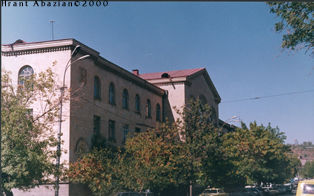|
The
faculty of biology has been founded in 1931 but the biological subjects
have been taught since the foundation of the University, previously at
the faculty of exact sciences, then at the medical and agricultural faculties.
Beginning its history only with 2 chairs, today the biological faculty
has become the very centre of the training for the republican biological
personnel as well as the centre of the development of the biological scientific
thought. The faculty has 8 chairs: chairs of biophysics, biochemistry,
botany, physiology of plants, microbiology, genetics and cytology, ecology
and protection of nature, human and animal physiology, which all have
scientific-research laboratories attached to them. The scientific investigations
of the department of biochemistry have as a goal to simplify the mechanism
of formation of ureotelism during the evolution process. By this purpose,
continues the investigations to explain the urea biosynthesis process
- the main mechanism of ammonium neutralization. It was established that
the formation of ureotelism by Amphibia is not a result of modification
of the existing in liver before metamorphosis enzymes and on this base
of their association with the 4 enzymes secured the biosynthesis of arginine.
By this way they are transformed to the mechanism which secures the urea
biosynthesis. The investigations continue to reach this principle thesis
with new facts. The conditions of introducing several medicinal plants
of Armenian flora into isolated cultures and their regeneration are elaborated;
the collection of some herbs under the threat of extinction is established;
isolated cultures of madder with the high level of anthraquinone synthesis
are obtained; tobacco transgenic plants with the bacterial b-1,3-glucanase
glucanase gene are constructed (in collaboration with the researchers
from the Institute of Molecular Genetics of RAS). Phenylalanine - ammonia-lyase
of topinambur tubers is studied and partially purified. At the Department
of Human & Animal Physiology by the neurophysiological and neuropharmacological
methods there is investigated neuronal and neurochemical organization
of central mechanisms of regulation of some viscero-somatic functions
of organism in norm and in conditions of extremal factors influence (vibration,
hypoxia, mental work etc.). It were revealed neurophysiological mechanisms
of functional state of different areas cerebral hemispheres at the modeling
of longterm monotonous work on the display. On the base of data received
it was presented methodics recomendations for the neurophysiological and
neuropharmacological correlation of nervous system functions disturbances
in conditions of influence of different extremal factors. The analysis
of the composition and the zoogeography of some widely-distributed groups
of animal species of Armenia was carried out; the numerous bee species,
novel for Armenia, were discribed; several species of cheiroptera were
investigated from kariological point of view. In collaboration with the
researchers from the Petersburg Institute of zoology the elaboration of
the theory of hybrid origin of parthenogenetic rock lizards of Armenia
was continued. Some aspects of the mutual conditionality of regeneration
processes of higher vertebrates internals were revealed. In the Department
of Genetics and Cytology and Research Laboratory of Cytogenetics the monitoring
of Armenian Nuclear Power Station is continued. It includes the genetic
monitoring of Nuclear Station workers and also its environment: different
plant populations, sewage water and ambient air. We are summarizing the
results of Chernobyl accident liquidators from Armenia research for the
presence of clastogenic factor in their blood, that can cause chromosome
aberrations and of DNA damages, detected by "Comet assay" technique (single
cell electrophoresis). The genetic mechanisms of periodic disease are
investigated. The role of free-radical processes in the revealed genetic
defects is demonstrated. The final goal of research is the formation and
testing of complex system of population and individual estimates in the
groups of genetic risk. It's studied for the first time the connection
and interrelation between the components of biogeotsenoses - the irrigation
water - soil - greenery - under the conditions of the industrial pollution
of RA and the processes of their innovation. The Chair of Botany is the
only scientific and training institution in the Republic preparing personnel
on spore plants. Chair of Botany has conducted the investigations to reveal
the specific composition of the fungi of Armenia, inhabiting in natural
and artificial ecosystems. There has been gathered a large stock of edible
and poisonous macromycetes, mycodestructors of industrial materials and
goods made out of them, studied their biological activity. There has been
carried out the monitoring of the contamination of foodstuffs and drugs
by toxic fungi and mycotoxins, similarly, there have been worked out methods
to subdue the mycodestructors affecting pulp and paper goods. The investigations
that carried out in the department of biophysics are devoted to studies
of molecular mechanisms of intracellular regulation. Particularly it is
shown that the steroid hormones that activate the biosynthetic processes
at the same time are able to influence on polyphosphoinositides composition
which are the key lipids of phospho-inositide regulatory mechanism. During
the studies of regulation of secondary metabolites synthesis by using
cell engineering methods some new ways of the induction of various metabolites
in different cell systems were revealed. The DNA-ligand cooperative transition
theory was elaborated and experimentally corroborated which takes into
consideration the possibility of simultaneous formation of arbitrary namber
of complexes with different polynucleotide forms. In the field of investigations
of functioning of ion-transporting systems in bacterial cells the participation
of formeate-hydrogen-lyase in hydrogen-potassium exchange was established.
It was also shown that the itracellular pH was regulated by both hydrogen
and potassium systems in E.coli cells. A new methodological approach was
elaborated by using the chemiluminescence in lipid-protein interactions
which is widely adopted in investigations of different pathologies.
|
